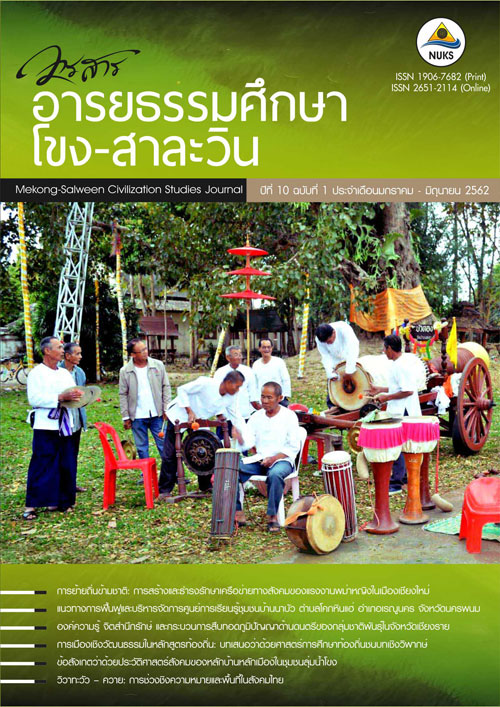ข้อตกลง
1. บทความทุกบทความจะได้รับการพิจารณาจากผู้ทรงคุณวุฒิ (Peer review) ที่ตรงตามสาขาวิชา โดยทุกบทความจะต้องผ่านการพิจารณาจากผู้ทรงคุณวุฒิ อย่างน้อยบทความละ 3 ท่าน
2. บทความ ข้อความ ภาพประกอบ และตารางใด ๆ ที่ตีพิมพ์ในวารสารอารยธรรมศึกษา โขง-สาละวิน เป็นความคิดเห็นส่วนตัวของผู้เขียน กองบรรณาธิการไม่จำเป็นต้องเห็นด้วยเสมอไป และไม่ใช่ความรับผิดชอบของ กองส่งเสริมศิลปวัฒนธรรม มหาวิทยาลัยนเรศวร ถือเป็นความรับผิดชอบของผู้เขียนแต่เพียงผู้เดียว
3. บทความจะต้องไม่เคยตีพิมพ์เผยแพร่ที่ใดมาก่อน และไม่อยู่ระหว่างการพิจารณาของวารสารฉบับอื่น หากตรวจสอบพบว่ามีการตีพิมพ์ซ้ำซ้อน ถือเป็นความรับผิดชอบของผู้เขียนแต่เพียงผู้เดียว
4. บทความที่ส่งถึงกองบรรณาธิการ ขอสงวนสิทธิ์จะไม่ส่งคืน
Restoration and Management strategies for Community Learning Center of Na Bua Village, Kok Hae Sub-District, Renu Nakhon District, Nakhon Phanom Province
แนวทางการฟื้นฟูและบริหารจัดการศูนย์การเรียนรู้ชุมชนบ้านนาบัว ตำบลโคกหินแฮ่ อำเภอเรณูนคร จังหวัดนครพนม
Keywords:
Reconstruction, Management, Community Learning Center, Na Bua VillageAbstract
The research of restoration and management strategies for community learning center of Na Bua Village, Kok Hin Hae sub-district, Renu Nakhon district, Nakhon Phanom province is a qualitative research. Its purposes are: 1) to study a current situation and community potential in order to revive and manage their learning center; 2) to study the current issues of Ban Na Bua learning center on problems and obstacles of its management; 3) to propose ways of participatory restoring and managing of Ban Na Bua community learning center. The tool used for data collection and analysis are semi-structured interview, participant and non-participant observation including record form. The sample group are chose as a specific sample group, including the village headman, the headman's assistant, a sub-district cultural council and community members who involved in running the learning center.
The study result found that 1) on current situation, after the opening of the August 7th Club and setting up the Learning Center committee in 2009, The Learning Center is yet functioned as it should be. Its management can describe as the villagers "help together" with community leaders. On the community potential to reconstruct the learning center, it was found that Ban Na Bua has many potentials to be developed effectively on the aspect of historical and cultural knowledge management in the future. For example some of village members have knowledge in history, culture and local wisdom. Also their new generations are enthusiastic people. The most important is the story of the community which has been made widely known through education and research. 2) The current problems and obstacles of Ban Na Bua community learning center are the dissonances of community members caused by historical imperceptive from textbooks provided by central government which is far from their understanding and cause people involved in the first gunshot day rang out being seen by people in the community as outsider. 3) On ways of participatory reconstruction, Ban Na Bua community learning center (1) have been registered, as a part of cultural objects, repaired storage and get organized its cultural resource database in basic way. (2) On exhibition method the Ban Na Bua History Learning Center has been designated as a community museum telling their story of political struggle era and the Phu Thai ethnic’s houses as a place presenting the tradition and culture of the Phu Thai who have been in Ban Na Bua since the past to the present. (3) On designing learning activities, as Ban Na Bua has many cultural resources which can integrate activities into school and university curriculum, it can be developed into various projects that can generate significant culture and sustainable economic in the future.
Downloads
References
Chaithiang, T. (2003). Farmer's Village Revolution at The northeastern part. Bangkok: sangsan.
Chalermpow Koanantakool, P. (2010, March). Experience from local museums and Public relations. Research Community. 15(90):18-21.
Isarapreeda, P. (1977). Nature and Learning process. 2th Ed. Bangkok: Klung Siam Printing.
Kaoyai, N. (2016, July-December). Learning Resources Center: The Sustainable Development of Higher Education Institutions. Southeast Bangkok Journal. 2(2): 108-123.
Kitiasa, P. (2003). Localism. Bangkok: National Research Council of Thailand (NRCT).
Lertchaanrit, T. (2007). Handout of 357511 CONCEPT AND THEORIES IN CULTURAL RESOURCE MANAGEMANT. of the 1nd semester of the year 2007, Faculty of Archaeology, Silpakorn University. N.P.: n.p. (Mimeograph).
Paicharnjit, S. (2007). Archaeological Resource Management in Community Development. Bangkok: Community Archaeology Books Project.
Princess Maha Chakri Sirindhorn Anthropology Centre. (1997). Local Museum in Thailand. Bangkok: Princess Maha Chakri Sirindhorn Anthropology Centre, Silpakorn University.
Rugwongwan, Y. (2011, January). Local Museum and Cultural Heritage Preservation of Local Community. Damrong Journal. 10(1): 1-24.
Saenmit, S. (2001). Phuthai’s Traditions at Nabua village, Khok Hin Hae sub-district, Renu Nakhon district, Nakhon Phanom Province. N.P.: n.p. (Mimeograph).
Sarawasee, P. and Boonyakiet, C. (2014). Museum Worker. Bangkok: Parbpim.
Walliphodom S. (2008). Museums and local history: Collaborative Learning process. .Bangkok: Vlek-prapai viriyahpant foundation.
Jitmaat, N. Head Villager of Nabua Village, section 13. Interviewed on January 16, 2017.
RittiKorn, K. President of Phutai at Na Bua Village. Interviewed on January 8, 2017.
Saenmit. C. community Philosopher of Na Bua Village. Interviewed on January 8, 2017.
Sawaytadul, N. Community members of Na Bua Village. Interviewed on January 16, 2017.







